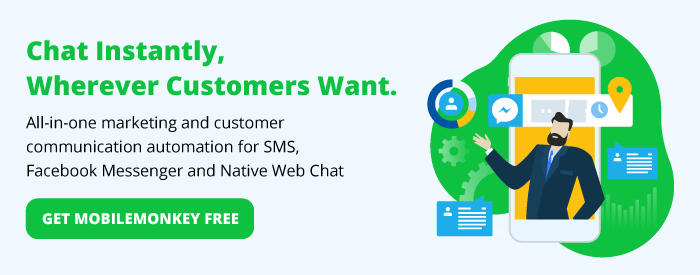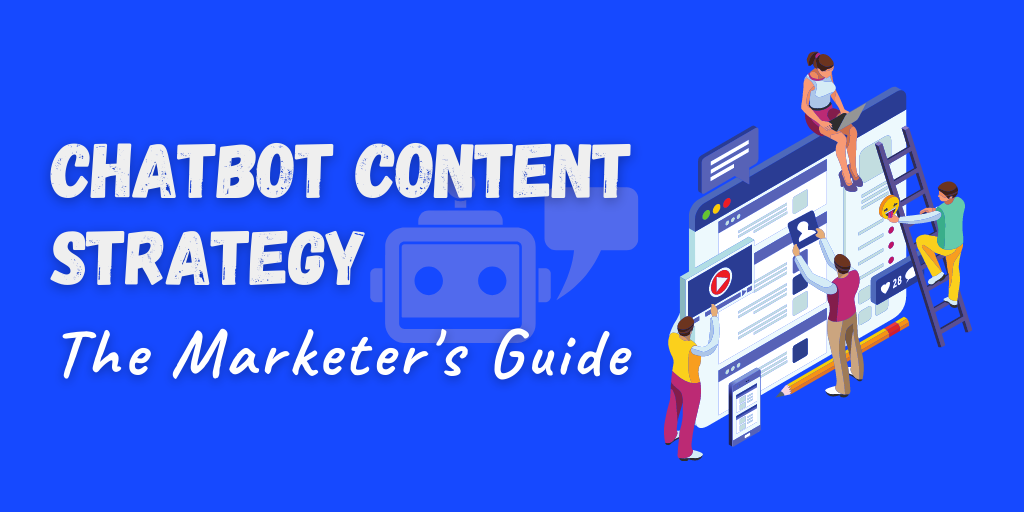If you’re seriously interested in learning more about how to build and execute a successful chatbot content strategy, you’re going to need this guide.
We’re going to dive into how to define your audience and objectives, how to use visuals in your strategy, and the importance of measuring your efforts.
We’ve got a lot to cover, so let’s get started.
- Step #1: Define the Audience of Your Chatbot
- Step #2: Define the Main Goals You Wish to Achieve
- Step #3: Choose the Content Formats You’re Going to Use
- Step #4: Use Visuals to Impress & Engage Your Audience
- Step #5: Measure the Success of Your Efforts
Step #1: Define the Audience of Your Chatbot
The first step that needs to be taken in order to create a successful chatbot content strategy is to define the audience of your chatbot.
That is, to define who your chatbot is going to be for.
Why is this important?
Because, by understanding and knowing the characteristics of your audience, you’re more likely to build the most appropriate chatbot for your target audience.
This will help you make sure that your audience is engaged and willing to interact with your bot and your content.
As an example, let’s talk about millennials.
If you’re making a chatbot that’s mostly addressing millennials, you should definitely know that they prefer texting over other forms of communication.
Have a look at the graph below to find out some of the reasons why millennials prefer texting.
And here’s some more interesting facts about the subject:
Here’s an example of this from eCommerce brand ASOS.
Because of the popularity of their business and the content that they post online, we can assume that the brand’s target audience is millennials.
Have a look at their social media posts below:
It looks like it’s made by millennials for millennials, right?
Let’s now look at what a Facebook Messenger chatbot conversation with the ASOS Help Bot looks like:
It’s all about texting.
The form of communication that – as we’ve discussed – this type of audience, millennials, prefers over others.
The company isn’t suggesting email or phone communication as an alternative contact option to their customers.
This is how the fact that they’re selling clothes to millennials affects their content strategy in general and chatbot content strategy in particular.
Simply put, if you’re a company that creates content, products, and services for millennials you should know the main preferences of your target audience and work towards giving them what they want and need from you.
The same principle applies to all types of audiences.
In the process of creating a chatbot content strategy, you need to first define your audience, and then analyze its preferences and needs so you can make sure that you create content that’s going to be engaging and useful to them.
Step #2: Define the Main Goals You Wish to Achieve
The second step that’s important in terms of building a chatbot content strategy is to define the main goals you want to achieve through this.
In other words, make sure that you know exactly what the goals of your chatbot content strategy are.
Defining the goals of your strategy is an important part of any marketing plan.
Knowing your aims will help you create a more effective strategy and take all the right steps.
There’s a wide range of goals that you might wish to achieve by using a chatbot.
They can be as many and as diverse as the companies that exist out there.
One of the main, and most common, objectives that a company might aim for is to promote its new content or products.
Have a look at the screenshots below:
As you can see above, the HubBot gives you the option to learn about the company’s products from the very beginning of your conversation.
It then makes sure to request as much information as possible so it can provide you with the most relevant information in regards to your query, as well as the reason you’re visiting the company’s website.
Ultimately, it gives you the option to either talk to a live agent about the company’s tools or try them out yourself for free.
Another goal that you might find of relevance to your business is using a chatbot to engage users and make them want to visit your website or chat with your bot again.
Let’s look at the Facebook Messenger Accuweather chatbot below:
By clicking on the ‘More Details’ CTA button I’ve highlighted for you, you’re taken to the company’s website where you can find details on the weather forecast for the city you’re interested in.
In a few words, the Accuweather chatbot above is a great example of how you can use CTAs to bring more people into your website and closer to your content.
Also, a rather important goal that can be easily achieved by using a chatbot is to let your audience know about any events and activities your company is organizing.
Let’s unpack this by looking at an example of how Customers.ai is using live chat to inform website visitors of a Chat Marketing Hack Webinar.
It does so by suggesting one of the company’s upcoming events as a way to help businesses today.
It then makes it easier for the viewer to reserve their seat and attend the webinar simply by clicking on the “Save My Seat” CTA button.
Yes, it can be as simple as that.
Before we move on to the third step I’m going to share with you in regards to creating a successful chatbot content strategy, I’d like to make sure we’re all on the same page in terms of the significance and diversity of goals that can be achieved through the use of a chatbot.
I’d like to highlight that the goals each company wants to achieve are always in relation to a number of parameters, such as the type of business or the characteristics of the market that a company is in.
What I mean by this is that the goals will be completely different for an eCommerce business that wants to succeed in sales than for a SaaS company that wants to generate leads or create products and services that are valuable to their audience.
I find the following graph extremely helpful in explaining what the needs of different businesses might be:
Author’s Note: It is evident that different types of bots serve different needs. While sales and marketing bots are effective for bringing in leads and even helping you convert some of these leads into paying customers, a customer care bot could help you establish more tight relationships with your customers and increase customer loyalty.
You might want to go through the types of bots that you see above when you start building your own bot for your business.
Step #3: Choose the Content Formats You’re Going to Use
This step has to do with choosing the content formats you’re going to use.
Put another way, the type of content that your bot is going to use to interact with your audience.
Choosing the right and most interesting content formats for your chatbot is important because that will form the type of communication that you’re going to build with your audience as well as the level of engagement.
Thankfully, there’s a wide variety of content formats for chatbots and so you don’t have to worry about your chatbot being too boring and flat.
A fantastic way to communicate with your audience through a chatbot is to share case studies and content pieces from your blog.
Below, I’ve got an example of that.
This is a direct and quick way to raise awareness of your blog as well as your products and services.
Author’s Note: To raise awareness about your blog, you can also use a PR software that will allow you to reach out to influential bloggers in your industry and share your best pieces of content with them.
Also, in terms of the effectiveness of the content format, if someone is already chatting with your bot, it probably means that they’re interested in what you do so you might as well give them some relevant and interesting content to read.
The same goes for the U-Bot of the OTT platform Uscreen.
The company uses its chatbot to share blog content.
Another content format you could use is links that lead to your website.
The example from the Facebook Messenger Spotify chatbot will make this a bit more clear.
As you can see, the chatbot above is not very chatty.
However, it gives essential information and links that lead to Spotify landing pages, like the one below:
And it also links to a Facebook page that’s to do with customer support.
In other words, even if you’re not into creating a bot that tells jokes and likes to talk, make sure you’re still giving information about your company through your bot.
Moreover, a type of content that you should definitely consider using is visual content.
The next step is all about using visuals in your chatbot, so I’ll elaborate on this below.
Step #4: Use Visuals to Impress & Engage Your Audience
As mentioned above, the second to last step I’d like to discuss with you is to use visuals in your chatbots in order to impress and engage your audience.
This step is firmly linked to the previous one because the content formats that you’re using can significantly affect the level of engagement and how much your audience is going to be impressed by your content.
Put another way, make sure you’re giving your audience compelling visuals that’ll increase the level of engagement with your chatbot content.
I believe that using interesting and engaging content can make a huge difference in the level of engagement that the company achieves in all types of content that it produces.
Chatbots are a type of content as well as a channel that gets a company to interact and communicate with its audience in a quick, fun, and effective way.
As with all communication channels that a company uses in order to stay competitive and in touch with its customers, your chatbots are more likely to be engaging if they’re unique and promote the brand experience that your brand has to offer.
Visuals are a quite broad category of content that can be shared online and through a chatbot.
A type of visual that can be used are images.
An image, even a simple one, accompanying text in a chatbot conversation, can make the whole experience feel more natural and engaging.
It adds the visual aspect to the overall experience of chatting with a bot that can increase the level of engagement.
Images are also great because they help you share information about your company in an eye-catching way.
Like in the image below:
Another type of visual content you should absolutely think about using is GIFs.
I can’t stress this enough.
A GIF is an animated image; a short video clip that’s played on loop.
They’re fantastic visual pieces of content because they’re usually fun and very easy to look at.
They’re also very easy to consume and so they manage to make a chatbot conversation more charming and pleasant.
Let’s have a look at a few examples of GIFs being used in chatbots.
The one above is cute, right?
How about the dancing monkey below?
What do you think about the quote of the real estate guy on this one?
Basically what I’m trying to say here is that GIFs give a personalized touch to a chatbot conversation.
Put another way, they make chatbot conversations feel more interactive.
Also, they’re far more likely to convince a website visitor to visit a landing page or opt-in for a newsletter than simple text.
For all the reasons mentioned above, I believe that you should consider making your own GIF and incorporating it into your chatbot using a customizable animated template like the one below.
Input your own call-to-action and make it match your brand colors and fonts to create a strong visual brand.
Step #5: Measure the Success of Your Efforts
The last step I’d like to share with you, and I believe it makes a huge difference when it comes to chatbot content strategy, is to measure the success of your efforts.
To measure the success of your efforts in relation to your chatbot content strategy basically means that you’re always aware of what works and what doesn’t.
That’s very important because it helps you maintain a successful and effective strategy.
Let’s discuss some of the most successful metrics that can be your guide in terms of measuring success.
The first metric is click-through rate (CTR).
The click-through rate basically shows the percentage of people who have seen and clicked on your ad.
Put another way, CTR shows you the ratio of people that hit a link to the total number of people that have seen a webpage or ad.
I’d like to give you the following definition on what CTR is so we can all be on the same page:
CTR is the rate at which something gets seen and clicked.
It can be a page, advertisement, or, in our case, a chatbot.
To cut a long story short, in terms of our topic – chatbots – CTR can help you measure the effectiveness of a chatbot by counting the percentage of people that clicked a link in your chatbot.
The second metric that you could consider using in order to measure the success and effectiveness of your chatbot is the open rate.
To put it simply, the open rate is a metric that measures how many people open an email or chat blast that a company sends.
When using chatbots, it’s important to know how many visitors and viewers are actually interested in opening them.
The percentage of people who’ve opened your chatbot means a great deal to how a company should deal with its overall chatbot content strategy.
Here are some impressive chatbot statistics on the open and read rates of a few chat blasters.
As you can see, the percentage of people who were sent a chat blaster and read it is very high.
That’s a great step in creating a strong and effective chatbot strategy.
The last metric that companies should use to measure their chatbots’ effectiveness is website visits.
This basically means that companies can measure the performance of a chatbot by measuring the percentage rate of website visitors that came via a chatbot link.
Like this one that we discussed earlier in this guide:
Having a clear idea about the number of website visitors that followed a chatbot link is a great piece of information that you can get.
Why?
It basically shows you if the links that you include in your chatbot conversations are indeed relevant to your audience.
Also, you’ll understand if they’re intriguing and engaging enough in terms of convincing people to engage more with your content and make them want to know more about your company, services, and products.
To sum up, after you’ve created your chatbot, always remember that measuring its performance will make a huge difference in the success of your overall strategy.
Now Over to You
You’ve made it all the way through this guide where we talked about what constitutes a successful chatbot content strategy.
When creating your chatbot strategy, remember the importance of defining the audience as well as the main goals that you wish to achieve by using a chatbot.
These two parameters will help you make sure that you’re creating an effective chatbot strategy.
Additionally, in this guide, I showed you some content formats that you should consider using and dived deeper into the magic power of creating and implementing visual content in your chatbots.
Finally, we discussed the role of some metrics in regards to measuring the effectiveness and level of engagement of your chatbots.
What are some of your chatbot challenges when it comes to your content strategy?
Important Next Steps

About the Author
Farzad is the co-founder of Respona, the all-in-one PR, and link building tool that combines personalization with productivity. He also runs the marketing efforts at Visme, where he helped the company gain over 5 million users and pass 1.5M monthly organic traffic. Since then, he’s been helping other companies achieve the same success via Respona.

